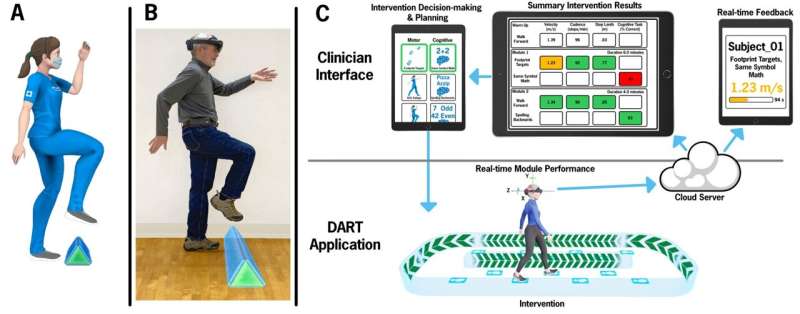
An augmented-reality headset is an effective digital tool for improving posture and gait in people with Parkinson’s disease, according to a recent Cleveland Clinic trial. Findings were published in Neurorehabilitation and Neural Repair.
Augmented reality, or AR, allows users to complete digital programs projected into the world around them. The “Dual-task augmented Reality Treatment” (DART) uses the Microsoft HoloLens2 to run patients through dual-task training (DTT), a series of tasks designed to engage the brain and body simultaneously.
Activities are designed to counter Parkinson’s disease’s effect on the parts of the brain that control mental and physical tasks. Think about walking while listening to an audiobook or talking while shopping at the grocery store.
DTT helps address the lack of balance and stability that can lead to falls or difficulty moving, says Jay Alberts, Ph.D., Center for Neurological Restoration, and the study’s first author. This therapy, although effective, isn’t widely used because of the time and resources it takes to measure patient progress and personalize a program, among other limitations.
Instead of a human therapist, the DART program uses a digital avatar named Donna, named after Dr. Alberts’s mother. The user puts on the AR headset and sees Donna in their line of sight. The user then hears instructions through the headset, which tracks their movements and responses. Donna guides the exercises and demonstrates movements. The headset collects data for clinicians to review and use to design future sessions.
“A digital platform that completes some of these tasks, down to collecting tiny alterations to someone’s stride, can help us standardize and implement DTT,” Dr. Alberts says. “The trial shows that using an AR headset or physical therapist directed DTT produces similar improvements in gait and postural stability.”
Training can improve posture and stability and prevent falls or “freezing.” Some examples of DTT activities include:
- Stepping forward when you hear an even number, stepping back on an odd number
- Waving when a light is green, crouching when it’s red
- Remembering a series of numbers while walking forward or navigating a digital obstacle course
DART can create more than 230 combinations of DTT activities. The clinical trial of just under 50 people compared results from participants in sessions led by an in-person therapist and those using the DART platform. Both groups showed comparable, clinically significant improvement after the therapy. Retention was also high for both groups, addressing another potential concern with implementing the therapy.
DART is not meant to take the place of a physical therapist, but to serve as technology to enable more widespread use of DTT, Dr. Alberts says.
“People diagnosed with Parkinson’s disease often balance physical therapy, new medications and specialist appointments with their lives and families, which is overwhelming,” he says. “Our goal is to make DTT more accessible, removing one more obstacle for patients who want to improve their daily lives.”
More information:
A Randomized Clinical Trial to Evaluate a Digital Therapeutic to Enhance Gait Function in Individuals With Parkinson’s Disease, Neurorehabilitation and Neural Repair (2023). DOI: 10.1177/154596832311841
Journal information:
Neurorehabilitation and Neural Repair
Source: Read Full Article
